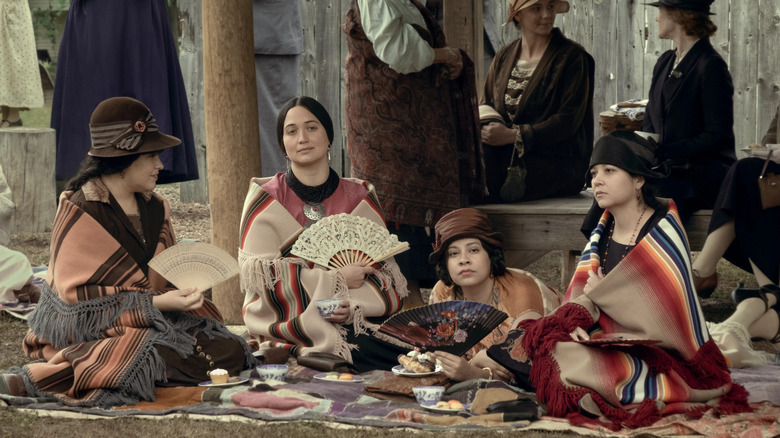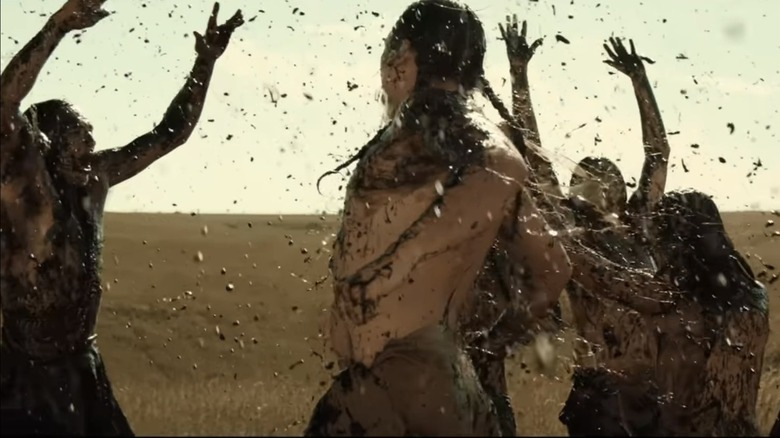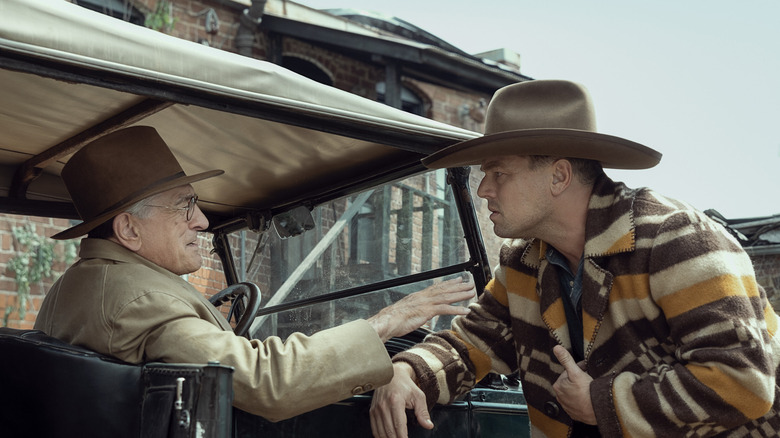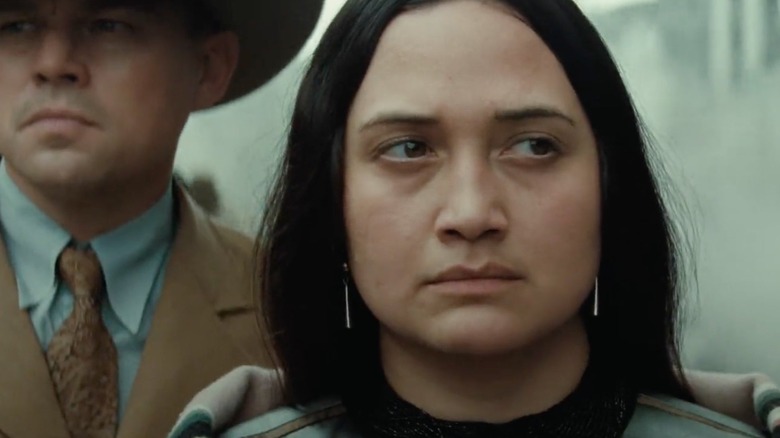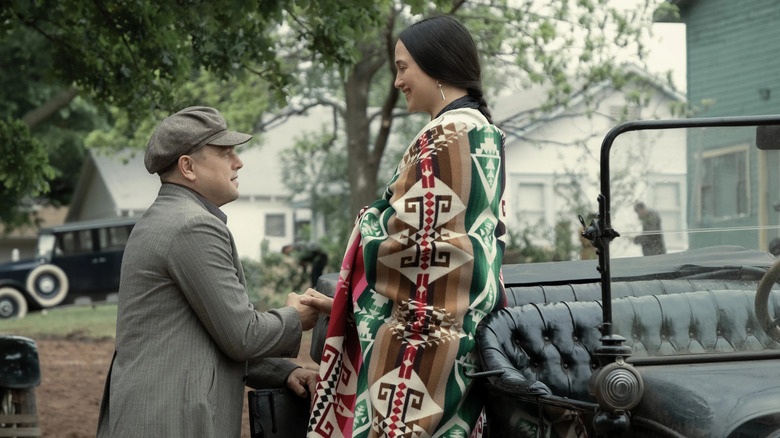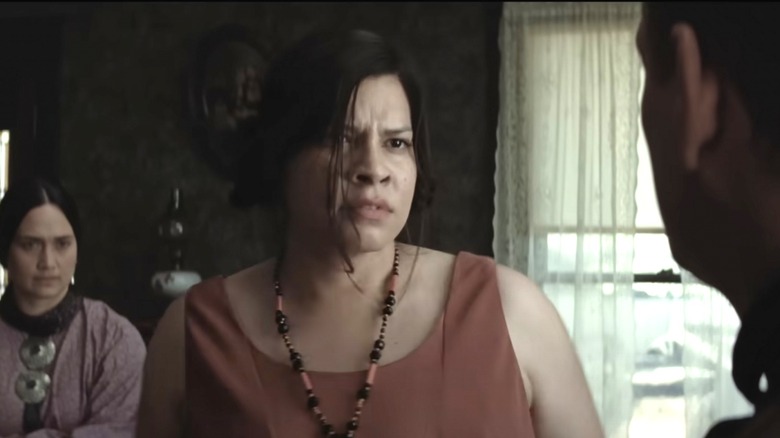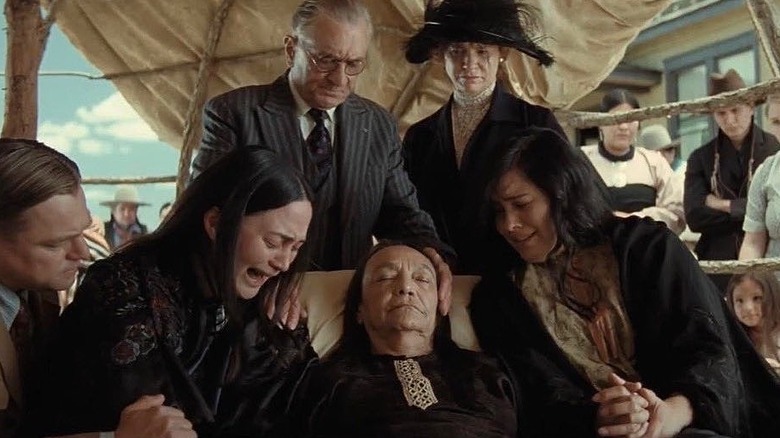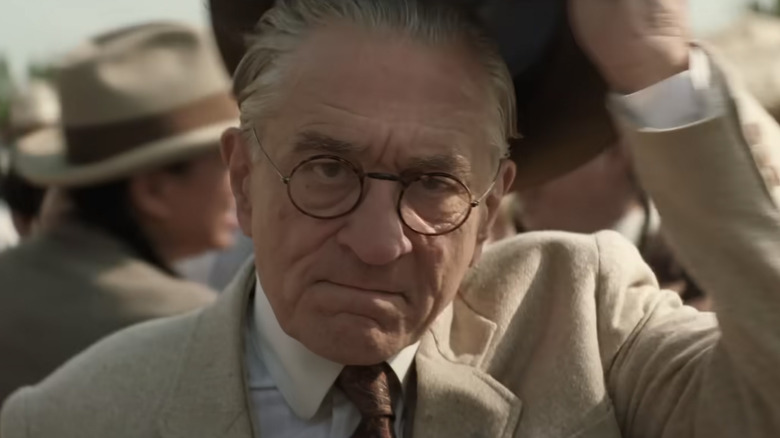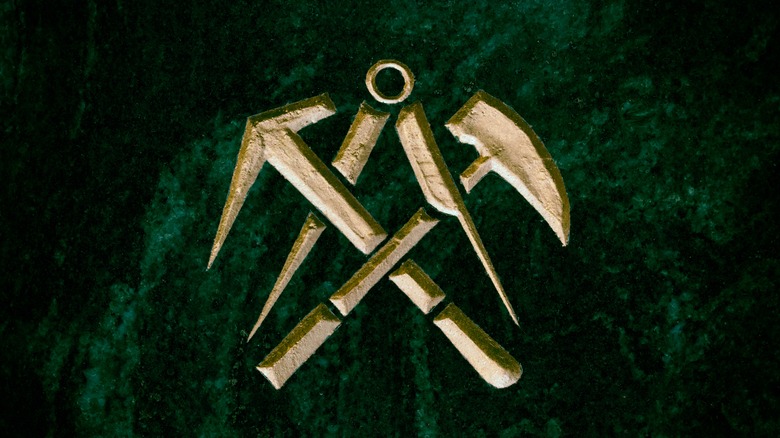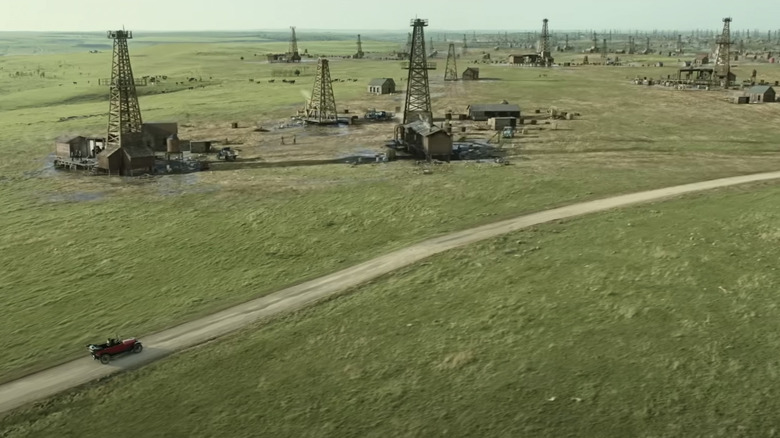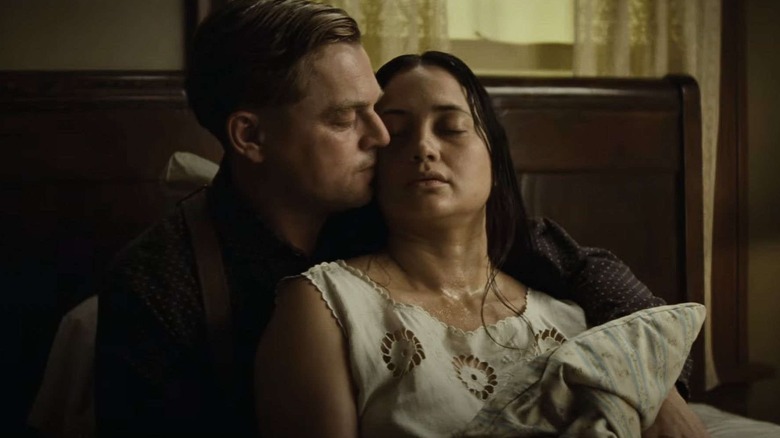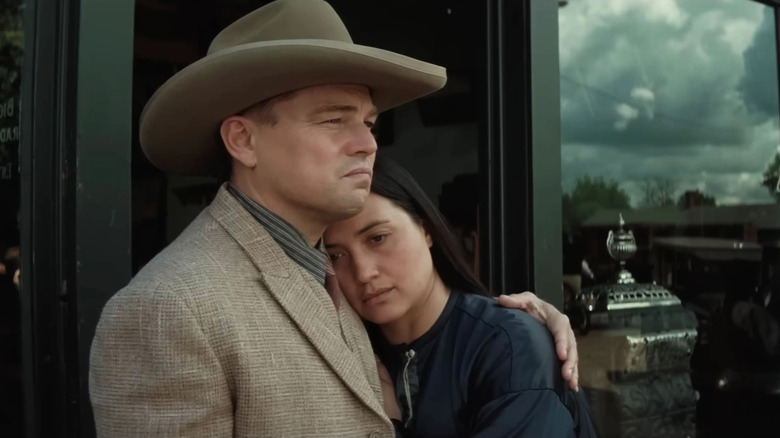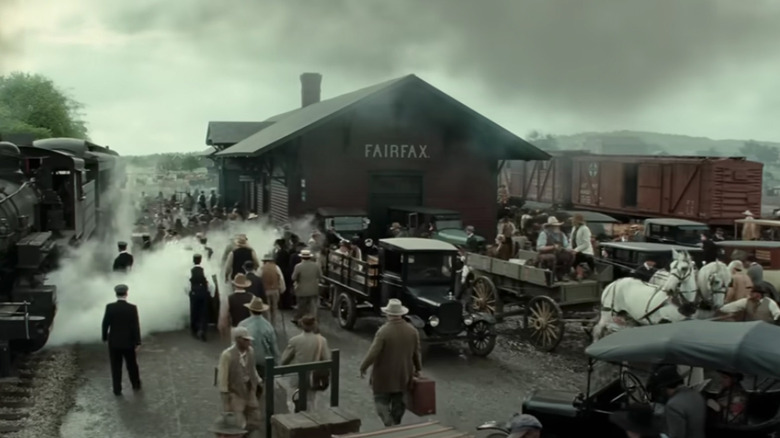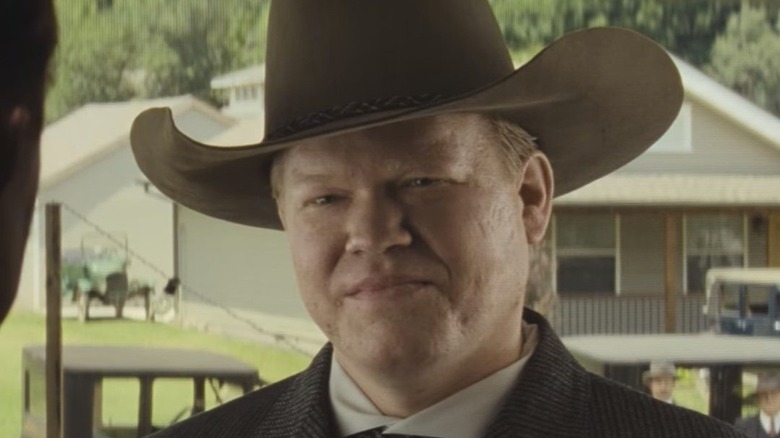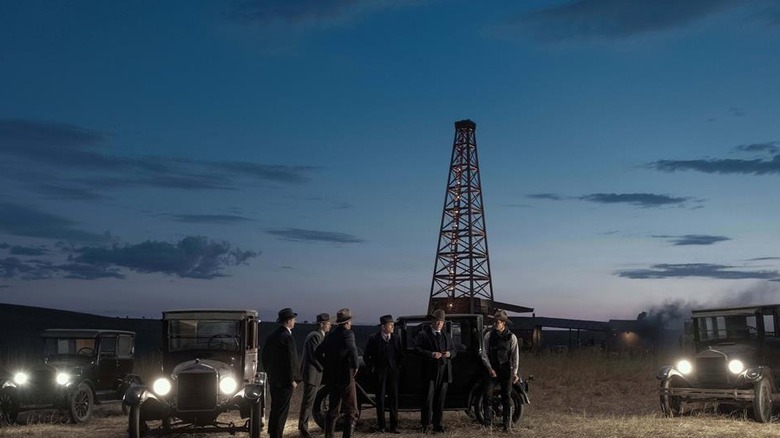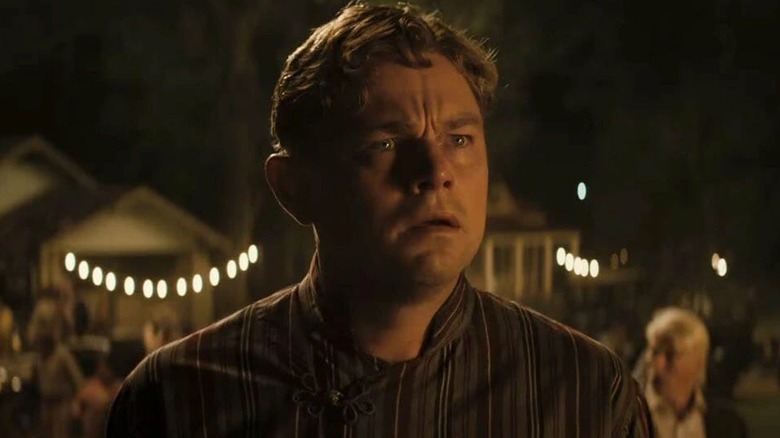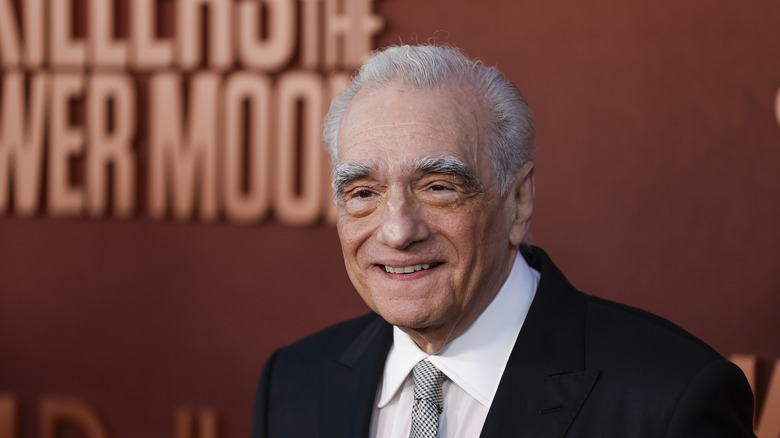How Killers Of The Flower Moon Differs From The True Story
In 2017, a true crime story called "Killers of the Flower Moon," written by The New Yorker staffer David Grann, became a sensation, at a time when the genre was taking over bookshelves, streaming services, and podcasting platforms. Grann's meticulously researched yet relatively slim volume told the compelling and all-but-unknown tale of a community of Indigenous Americans in turn-of-the-century Oklahoma who'd struck it rich during an oil boom, only to become the targets of what seemed like nefarious criminal plots. "Killers of the Flower Moon" had all the makings of a great page-turner: love, lust, greed, murder, not to mention twists that were almost too shocking to be true. But true it all was.
Martin Scorsese has been explaining on a press tour (via Time) for his new film that he reworked the script to be less about white characters, to focus more on the Osage characters. The book is told in three parts, or chronicles, two of which make up the majority of the page count. The first is largely from Indigenous American Mollie Burkhart's perspective, the second is from federal agent Tom White's. Curiously, Scorsese spends far more screen time dramatizing what might've happened in dark rooms between the conspirators (who also happen to be white guys). The film still manages to get most of the important details right, but the change in framing and the time constraints (even at three hours and 26 minutes) have necessarily led to some inaccuracies and omissions. This is how 2023's film "Killers of the Flower Moon" differs from the 2017 book version, and what really happened in Osage County all those years ago.
Contains spoilers for "Killers of the Flower Moon"
How the Osage ended up in Oklahoma
Martin Scorsese's film adaptation of "Killers of the Flower Moon" kicks off when the Osage discover an oil deposit on their reservation, just as Ernest Burkhart (Leonardo DiCaprio) arrives on a train to try his luck in the black gold-rich Indigenous American territory. From the moment DiCaprio's face comes into view, the audience experiences the rest of the movie through Ernest's eyes, which is a major departure from the book. How the Osage got to Oklahoma in the first place, as well as how they ended up in possession of their land (and, more importantly, their mineral rights), is glossed over; all of the action takes place at the height of the so-called Reign of Terror. It's mentioned in dialogue that the Osage were driven from their ancestral home, but with few other details.
David Grann outlines in the book version of "Killers of the Flower Moon" how President Jefferson, after having acquired the Louisiana Purchase from the French, promised peace with the Osage who lived there. It wasn't to be: In the years that followed, Jefferson threatened the Osage into signing a treaty, lest they become enemies of the state, that would eventually rob them of roughly 100 million acres of their native land and push them west. Mollie Burkhart's ancestors ended up in Kansas, where white settlers soon terrorized the Osage. The tribe decided the best way forward was to purchase land that white men wouldn't want. They bought the hilly, rocky terrain that would eventually make them unimaginably wealthy for 70 cents an acre, because it wasn't hospitable to Western-style development.
William Hale and Ernest Burkhart's ages
Though they exist slightly more in the periphery of David Grann's book, William Hale (Robert De Niro) and Ernest Burkhart are arguably the two main characters of Martin Scorsese's "Killers of the Flower Moon." Hale is depicted as empathetic toward the Osage, generous, and charming ... at least at first. Later, he's shown to be cold, cunning, and calculating to no end. Burkhart comes off as something of a simpleton with a weakness for women. These portrayals closely resemble the picture Grann paints, with one key difference. As played by De Niro and DiCaprio, they're both much older than their counterparts would've been in real life, which has an effect on the story's veracity.
According to the book "Killers of the Flower Moon," Ernest Burkhart was just 19 years old when he arrived in Fairfax, Oklahoma, to do odd jobs for his uncle. He's meant to be about 28 during the time most of the movie's action takes place, and Grann's book suggests that his youth and handsome face were part of what attracted Mollie (Lily Gladstone) to Ernest. DiCaprio certainly has a movie star's good looks, but at 48 years old when the film was released, he was more than double the character's real age at the film's start. Similarly, William Hale was between 40 and 51 years old when he was wielding influence over nearly everyone in and around Fairfax. With his history of playing villains and anti-heroes, De Niro is as intimidating as Hale would've been, but at 80, he's also three decades more elderly.
Osage names
In the film, William Hale ingratiates himself with the Osage by respecting and sometimes even participating in their cultural traditions. Of Mollie's father, he says that he always made it a point to call him by his Osage name, Ne-kah-e-se-y. Characters in the movie also discuss how the Osage don't really belong until they are given their Indigenous American name, and once it's been bestowed upon them, it can never be taken away. That's a nice sentiment, but as Mollie and her sisters, as well as her mother, are all referred to by their anglicized names throughout the movie, it didn't hold true.
David Grann's book "Killers of the Flower Moon" provides readers with the girls' real names, as well as the story of how they lost them to time, even during their own lives. But first, Ne-kah-e-se-y lost his name, sitting outside a trading post. As the settlers and prospectors got to know him while he was selling furs, they gradually began to call him Jimmy. Before long, his four daughters would be given white names, too. Wah-kon-tah-he-um-pah became Mollie. Once, America had dealt with Indigenous inhabitants by containing them on reservations, but the mood had shifted, and during Mollie's childhood, assimilation was preferable. That meant girls like Wah-kon-tah-he-um-pah were made to learn English, attend church, and practice the skills of the American housewife. Wah-kon-tah-he-um-pah, or Molly, was just 7 when the government sent her to a boarding school for this purpose.
Spending habits
The film adaptation of "Killers of the Flower Moon" does a good job of illustrating how the Osage dealt with prejudice — and horrific unfairness pertaining to their access — to their vast wealth. It's true that the tribe made tens of millions of dollars off of their mineral rights, and it's true that they were subjected to a kind of bureaucratic oppression by way of a system that installed white conservators to oversee their fortunes. At dinners held by Mollie and Ernest, in local places of business, and on the streets, white characters complain about the Osage's comfortable standard of living and their lack of a need to work.
Montages and photographs at the film's beginning show Osage women dressed up in French finery with flapper haircuts. That would've been what visitors to Fairfax would've seen for themselves in the early 20th century. But bigoted rumors of the Osage's lavish spending habits went beyond car and home ownership, and Martin Scorsese makes allusions to these prejudiced beliefs without fully explaining that they didn't hold water. In the book "Killers of the Flower Moon," David Grann tells how journalists would write sensational stories about wasteful Osage, who would throw pianos out on their lawns or buy new cars every time one got a flat tire or ran out of gas. In the film version of "Killers of the Flower Moon," Bill Smith (Jason Isbell) sits by a left-behind piano in his new house, and a car salesman tells an Osage woman to come back for a new model if she gets a flat tire or runs out of gas. The reality was, the Osage's spending habits were no different than those of wealthy white Americans.
Anna's murder
The murder of Mollie's sister, Anna (Cara Jade Myers), is — along with the murders of Bill and Reta Smith (Janae Collins) and Henry Roan (William Belleau) — one of the cases that makes up the central narrative of both the book and the film version of "Killers of the Flower Moon." In the film version, however, Anna's death is never much of a mystery. It's heavily implied in a coded conversation between Ernest and his brother Byron "Bryan" Burkhart (Scott Shepherd) that Hale wants Anna taken care of, and that the evening of Mollie and Ernest's dinner party is the night to do it. Only the details – Byron was the accomplice, and Kelsie Morrison (Louis Cancelmi) fired the gun — are left unresolved until the end.
In real life, there were multiple plausible suspects, which made cracking the case especially difficult. According to the book "Killers of the Flower Moon," Anna had been married to a man named Oda Brown, an unsavory character whom she'd written out of her will. As Anna had a reputation for drinking and carousing with men in boom towns like Whizbang, Oda would've had plenty of reasons to want her dead. Early in the investigation, a man confessed that Oda Brown had paid him $8,000 to kill Anna. A private investigator also followed a lead that claimed a jealous woman named Rose Osage had done in Anna after the latter had gone after her boyfriend. And, as it turned out, some of the very people who were supposed to be solving Anna's murder were actually obstructing the investigation.
Osage burial customs
At the very beginning of the film "Killers of the Flower Moon," an Osage chief announces that he's symbolically burying the tribe's ceremonial pipe, as a way of mourning the dying out of their people's traditional ways during the time of coercive assimilation. This may well have happened: The Osage did use such pipes in rites and rituals. No ceremony quite like this takes place in David Grann's accounting, however. What Grann does illustrate is the burial customs of the Osage as members of the tribe are systematically murdered and laid to rest. Again, Martin Scorsese alludes to these customs but doesn't explain them or show them in their entirety.
In the film, because the deceased Anna's face isn't intact, Mollie wakes up in the middle of a nightmare worried that the Osage god won't recognize her older sister and welcome her into the afterlife. In the print version of "Killers of the Flower Moon," Mollie is upset at her funeral that, because of her corpse's condition, her face cannot be painted to signal to Wah-Kon-Ta that her spirit is to join with those of her ancestors.
Also during the film, during Lizzie's and baby Anna's funerals, apples are placed on top of the casket. When Lizzie passes, the audience watches as she's reunited with her ancestors in what's implied to be a spirit realm. The book is more explicit about these references. The Osage would pack the casket with food meant to last the three days it took the person inside to reach the "Happy Hunting Ground," or the Osage's concept of heaven.
Anna's baby
There's a great deal of overlap between how Anna Brown's life and death are represented in David Grann's book and in Martin Scorsese's movie. Both characterize the eldest of Lizzie Q's four daughters as a woman who finds trouble easily. She really did carry a pistol in her purse when she went out, according to the book "Killers of the Flower Moon," and she went out a lot ... so much so that Mollie was able to reassure herself, for the five to seven days that her sister was missing, that she probably had just skipped town to have an impromptu adventure. And, as happens in the movie, Anna really did cause a scene at Mollie's house the night she went missing. She did tell Byron she'd kill him if she caught him with another woman, and she confessed to a driver that she was pregnant.
But Scorsese's movie leaves open a question that Grann answers in his book. Grann points out that some in Anna's inner circle knew she was pregnant. In the film, the news of Anna's pregnancy comes as a surprise to all. William Hale asks Byron if anyone has been gossiping about Anna's unborn child, implying that it could've been Byron's or even Hale's. This indicates that both men had affairs with Anna from this exchange, but the line of dialogue is not definitive. According to the book, several witnesses claimed that Hale had carried on a relationship with Anna and was the father of her baby.
The Masons
Midway through the film version of "Killers of the Flower Moon," William Hale becomes increasingly displeased with the behavior of his nephew, Ernest Burkhart. Ernest has been making mistakes: His scheme to have Blackie Thompson (Tommy Schultz) steal his car for the insurance money backfired spectacularly. A potential henchman wound up in prison, and the whole ordeal had the effect of putting unwanted attention on Hale and Ernest, making them vulnerable to snitches should Blackie ever turn (which is exactly what happens). Ernest also fails to prevent his wife from lobbying for more intervention from private investigators and law enforcement regarding the murders. To make sure he understands the severity of the situation he's in, Hale and Ernest's brother, Byron, escort him into a room within the local Masonic Lodge, where Hale bends him over backward and beats him repeatedly with a large paddle until it breaks.
According to David Grann, William Hale was the kind of man who not only amassed real political power but also symbolic status. He was a reserve deputy sheriff ... an honorary position that nevertheless allowed him to carry a badge and firearms and meddle in criminal cases. He also took to calling himself Reverend as well as King. Hale did wear a Mason's lapel pin, but there's no mention of any official affiliation with the secretive organization in the book. Records exist showing that Hale was initiated into the local branch, but they suggest that he likely wasn't a very high-ranking member. This tense scene is almost certainly a Martin Scorsese invention, in keeping with his style of intrigue-laden organized crime sagas.
Government corruption
Perhaps the most significant omission in Martin Scorsese's "Killers of the Flower Moon" is the scope of the corruption in the burgeoning governments and industries of Osage County, which extended all the way to what would become multinational corporations and the White House.
As Ernest Burkhart arrives in Fairfax, townsfolk advertise opportunities to the men disembarking from the train. Some hold signs bearing names like "Phillips" and "Burbank." It's mentioned once in the film that Osage headrights couldn't be sold. But drilling leases could be, and that's what's going on in the background. David Grann describes how major players like Getty, Phillips, Sinclair, and representatives from Gulf Oil would show up at Fairfax auctions run by the Department of the Interior and spend, on occasion, more than a million dollars for access to choice tracts of land.
These same families and companies would use their vast incomes from the oil derricks to influence federal government officials into enacting policies that benefited their interests, which allowed their businesses to grow exponentially. They supported the election of President Warren G. Harding, and infused his campaign with cash. The infamous Teapot Dome scandal that occurred on Harding's watch has indirect ties to the Osage killings. The same oil men who bought leases at Fairfax auctions also bribed the Secretary of the Interior with hundreds of millions of dollars. In exchange, they got secret, lucrative contracts to formerly-protected Naval petroleum reserves, like the one near Teapot Dome Rock in Wyoming.
What Ernest knew
A consequence of making Ernest Burkhart the anti-hero protagonist of "Killers of the Flower Moon" is that the film has to create an inner life for him. David Grann relies only on the historical record, in which Ernest's true feelings and motives remain a mystery.
In the film, Ernest has little problem dispatching the Osage, including his wife's family members, but he deludes himself into forgetting that, in the end, Mollie will have to die, too. DiCaprio's Ernest testifies under oath that he genuinely fell in love with his wife when he worked as her driver, and as his fate becomes unavoidable, he seems only to care about his family's well-being. Even after she learns he was involved in her sisters' deaths, Mollie remains devoted to him. She only walks away when he struggles to say whether he gave her more than insulin when administering her injections.
Grann writes in the book "Killers of the Flower Moon": "Burkhart never admitted having any knowledge that Mollie was being poisoned. Perhaps this was the one sin that he couldn't bear to admit. Or perhaps Hale had not trusted him to kill his own wife." Instead, the Shoun brothers, who were probably still responsible for the injections, were questioned about them. That doesn't mean Mollie was as understanding as she is in the movie. In real life, Mollie did cling to the "illusion of their marriage," even after her health improved when she was removed from her husband's care. But as soon as Ernest was proven to be complicit in the murders, she divorced him and "recoiled in horror" at the mention of his name thereafter.
Mollie's whereabouts
The film "Killers of the Flower Moon" also takes some creative liberties with Mollie Burkhart. Possibly because the character, who's suffering from diabetes, is restricted to a bed for most of the film's runtime, Lily Gladstone is given more to do in a fictionalized scene with some historical basis. After the private investigator they've hired goes missing (we know he's been killed), Mollie makes the trip to the nation's capital to implore President Calvin Coolidge to do something about the unsolved Osage murders. He acquiesces, and the Bureau of Investigation is formed in part to deal with this precarious situation, which exists in a legal gray area because some of the crimes have taken place on federal or Osage land, while others remain within the jurisdiction of the state.
That's not exactly how it happened. According to David Grann, the Osage Tribal Council did draft a formal resolution urging the Justice Department to intervene, as shown in the film. But Grann's book acknowledges that Mollie — who had become paranoid, and reasonably so — disappears from the historical record until 1925. As far as anyone knows, she didn't travel to Washington D.C.; instead, a lawyer and a Kansas Senator, both part Indigenous American, pressured the government to do something. Calvin Coolidge did meet and pose for pictures with Osage representatives, but Mollie doesn't appear to have been one of them.
Private investigators
At one point in the film, Mollie's family hires a private investigator. She's introduced to one William J. Burns, who colorfully rattles off his address as being just about every big city on the planet. Burns takes the case, but is promptly silenced by Ernest and Byron Burkhart, just as the Osage's chosen representative, Barney McBride, was. Later, at dinner, Hale convinces Mollie that the PI has simply skipped town with her money, since she made the mistake of paying him first. He and Ernest know full well what really became of the gumshoe.
Burns was a real private investigator, and the book "Killers of the Flower Moon" provides much more information about him. He really did introduce himself with that overlong slogan. Burns was a pioneer in the field of private investigation who excelled at self-promotion (he wrote detective stories about his exploits), so much so that Sir Arthur Conan Doyle dubbed him the American Sherlock Holmes. But Burns himself didn't work for Mollie, and he didn't die at the hands of the Burkhart brothers. The Osage hired not one but several private investigators to pursue leads. They operated anonymously, using numbers as code names, and many worked under Burns as employees of his detective agency. However, it was later revealed that Scott Mathis, the owner of the Big Hill Trading Company, which was the town's retail center, had served as a middleman. Mathis was loyal to William Hale, which meant at least some of the detectives hired to solve the case were actually being paid to provide cover for the criminal conspirators.
The murder of W. W. Vaughn
Despite its sweeping cast and ambitious runtime, Martin Scorsese's film "Killers of the Flower Moon" cuts one of the most consequential characters — and murders — from David Grann's book. According to Grann, an altruistic former prosecutor named W. W. Vaughan tried to get to the bottom of the Osage Reign of Terror and lost his life in the process. In 1923, yet another Osage was poisoned. This time, it was George Bigheart, a prominent and well-respected community member, whose uncle had been the tribe's last traditional acting chief. A friend of Bigheart contacted Vaughan and told him to meet them urgently, as they had information about the murders that could, at long last, lead to justice.
Vaughan left at once, but not before telling his wife about the location of the documents in question. He'd also left money for her in case anything happened to him. He arrived in time to find Bigheart alive, but the Osage succumbed to the poison and died hours later. Nevertheless, Vaughan alerted the local sheriff that he'd solved the case ... Bigheart's and the rest. He left via train with the evidence in hand. Tragically, he never arrived at his destination. Vaughan was found 36 hours later. His neck had been broken, his clothes had been stripped, and his body had been thrown from the train. The evidence was gone, as was the money he'd hidden away for his wife and children.
It's Vaughan's murder that, in part, enabled Grann to write his book. His granddaughter, Martha, was one of Grann's most valuable sources, and she filled in blanks that FBI files and court records couldn't.
Tom White
In rewriting the film "Killers of the Flower Moon" to focus more on Ernest and Mollie Burkhart, Martin Scorsese and co-writer Eric Roth drastically reduced the role of Tom White (Jesse Plemons), who was originally supposed to be the lead played by Leonardo DiCaprio. White is the protagonist of the second half of David Grann's book, which reads in part like a character study of this real-life Texas Ranger turned federal agent. In the film, he's little more than a functionary in a wide-brimmed hat. He arrives at the Burkhart home at the start of his investigation and (unsuccessfully) pressures Ernest to let him see Mollie. That didn't happen. But White assembled a team of undercover agents, including a rancher, an insurance salesman, and an Indigenous American looking for long-lost relatives, as depicted in Scorsese's "Killers of the Flower Moon."
Otherwise, much of White's fascinating backstory is left unexplored, as is what became of him after his tenure in Osage County. According to Grann, White was a nonviolent man by nature, despite his profession, though his bravery and intelligence outshined his capacity for administrative work and novel scientific methods of detection, which often put him in opposition to J. Edgar Hoover. His father had been a wholly decent sheriff, who felt the extrajudicial lynches in the South stained America's reputation. Tom learned his trade and his morals from his father, which he applied to the cases he took on in Fairfax.
Later in his career, he was taken as a hostage during an attempted prison escape and was shot in the arm and chest. He survived and lived to be 90 years old.
The founding of the FBI
In addition to being a profile of agent Tom White, the print version of "Killers of the Flower Moon" is also the story of the founding of the Bureau of Investigation ... the intelligence gathering and law enforcement organization within the American government that would shortly thereafter be renamed the Federal Bureau of Investigation, or the FBI. In fact, the subtitle of David Grann's book is "The Osage Murders and the Birth of the FBI." But by switching the point of view from White to Ernest Burkhart, Martin Scorsese necessarily excises the FBI plot (it's too significant to be called a subplot).
In contrast, chapter upon chapter in the book deals with the agency's inner workings, and the methods and technologies developed either just before or concurrent with the Osage murder investigations. J. Edgar Hoover's name is mentioned but once in the film. He's a looming presence in Grann's reporting and, of course, in history.
Rather than lone rangers with guns drawn, Hoover's ideal crime fighters were multi-skilled and highly capable cogs in a machine (graded on a scale of 0 to 100 in multiple categories of aptitude). They were taught to identify suspects with the use of mugshots and fingerprinting, and they were expected to be able to remain undercover for long periods of time and entrap their targets by outwitting them at their own games. The film includes characters like John Wren (Tatanka Means) working undercover as well as scenes in which suspects like John Ramsey (Ty Mitchell) buckle under pressure, but it doesn't attempt to tell the FBI's origin story.
The radio show
The film "Killers of the Flower Moon" concludes with an unexpected framing device. The camera pulls away from the Osage, and suddenly, the audience realizes what they've been watching has been the subject of an early 20th-century true crime radio show, complete with scripted reenactments, foley effects, and sponsors. There's a discomfiting zaniness to the affected retelling, and the viewer is taken even more aback when Martin Scorsese himself appears to read what amounts to a postscript.
The somber reality is that the public quickly lost interest in the story of the Osage murders. After providing a brief summary of what became of all the key players (upsettingly, Hale and Ernest were both released and lived out the rest of their long lives without further punishment), Scorsese tells us that Mollie's obituary (she died at 50) memorialized her dead family members but failed to mention that they were killed in cold blood by her husband and his associates.
As David Grann describes in his book, told from his perspective, the awful true story of the Reign of Terror really was turned into a radio program, paid for by Lucky Strike Cigarettes. However, the show was produced at the behest of J. Edgar Hoover and the FBI to valorize the agency's achievements. Rather than lamenting the injustice Mollie's family faced, even in death, the actual radio show about the Osage murders wrapped up on this note: the criminal Hale was, "no match for the Federal Agent of Washington in a battle of wits."
The scope of the conspiracy
While the film "Killers of the Flower Moon" ends on a down note, it's nothing like the sinking feeling the reader gets when David Grann widens the lens on his version of events. Throughout Martin Scorsese's movie, short scenes — sometimes only a single shot — depict various Osage victims and the manner in which they were murdered. Bill Stepson is shown choking from poison. An Osage woman is gunned down at close range outside her home; the murder staged to look like a suicide. The movie uses the figure that's generally attributed to the Reign of Terror: when all was said and done, approximately 24 Osage lost their lives due to Hale's malevolence.
The book "Killers of the Flower Moon" ends with the sentence: "There was another layer to the case — a deeper, darker, even more terrifying conspiracy, which the bureau had never exposed." Grann claims that William Hale was only one of many killers picking off Osage for their headrights and fortunes. While the Reign of Terror is said to have lasted from 1921 to 1926, Grann uncovered suspicious deaths that dated from 1918 to 1931. Records show that many, many Osage women died under the guardianship of the supposedly upstanding white men who controlled their estates, and for the most part, their deaths were never investigated. Hundreds of Osage may have been the victims of the hate and greed that fueled the killings, which were carried out not by one family of conspirators, but by an entire town's worth.
If you or anyone you know is struggling or in a crisis, or has experienced a hate crime, contact the relevant resources below:
-
Call or text 988 or chat 988lifeline.org
-
The VictimConnect Hotline by phone at 1-855-4-VICTIM or by chat for more information or assistance in locating services to help. If you or a loved one are in immediate danger, call 911.
